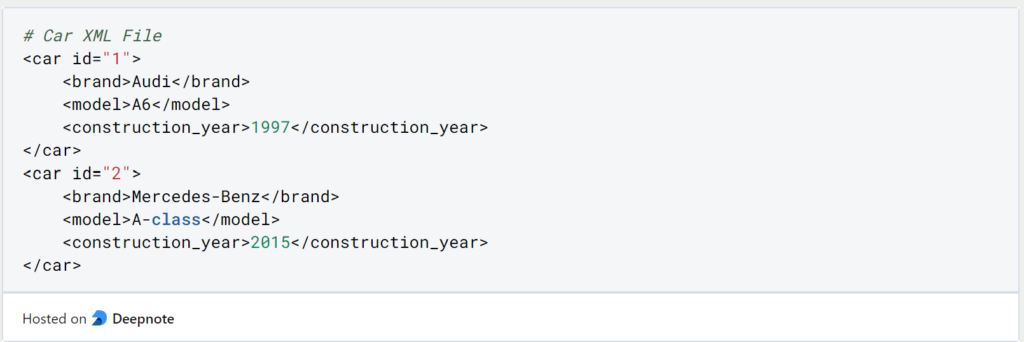XML stands for Extensible Markup Language and is used today as a text-based data format for the exchange of structured data. It was originally developed to replace HTML because it had reached its limits in terms of data technology.
How are XML files structured?
The so-called markup languages, such as HTML or XML, use markup to structure textual information. In HTML there is a fixed set of markers, which are defined in angle brackets (<>). These include, for example, headings (<“h1”>, <“h2”>,<“h3”>, …) or paragraphs (<“p”>), which are used to build up the structure of a website.
For example, this is the structure of a very simple website. The markups define the structure of the page, which currently consists only of a heading and a short paragraph.
XML uses the same structure with the difference that the amount of markups is not limited and their namings are freely selectable. This makes it relatively easy to emulate many types of data structures.
The only rules given by Extensible Markup Language are that markups must always start with an opening tag <“markup_1″> and end with a closing tag </”markup_1”>. The only exception is a tag with this form <“markup_1″/>.
To display nested information, several new tags can also be defined within an open tag. Here is an example:

An additional functionality is the so-called parameters. These can be defined for each markup and must always contain a name and a value. The value must be defined in quotes, even if it is a number.
In our example, the introduction of parameters is useful when we want to describe multiple cars in a collection:

Advantages and Disadvantages of the Extensible Markup Language
The following advantages are offered by the use of Extensible Markup Language files:
- Wide distribution and thus high compatibility with already existing applications
- High security of the files
- Easy recovery of information due to the readability of the text files
- Easy interpretation by man and machine
- Simple structure and layout, so that it can be quickly understood by many users
- Extensibility in the form of “dialects”
The only real drawback to this long list of positives comes from the textual format that the Extensible Markup Language uses. Textual information can only be stored with comparatively more memory and can therefore lead to lower performance in processing. Binary file formats, such as BSON, require significantly less storage space for the same information, but are not human readable because the information is stored in zeros and ones.
Which Applications use the Extensible Markup Language?
Due to the text-based storage of the Extensible Markup Language, the format is relatively easy to read and understand. This is why it is used for a wide variety of applications. One of the most common use cases is data exchange, i.e. importing and exporting data in applications.
In addition, there are few general uses of the Extensible Markup Language, as most use cases have created a variation of XML that is specific to their application. For example, there is the Mathematical Markup Language (MathML), which is a dialect of the extensive markup language and is used to correctly represent mathematical equations and terms.
What tools and programs are available for working with XML?
XML (Extensible Markup Language) is a versatile markup language that is widely used for data exchange between different platforms and technologies. Over the years, various XML tools and technologies have been developed to facilitate data management and manipulation. These tools and technologies make it easier for developers and users to work with this type of document.
The following are some of the most commonly used tools and technologies to handle this specific data type:
- XML parsers: These are software programs that read such a document and create a tree-like structure of the document. This structure can then be edited and queried using programming languages such as Java or Python. The most popular XML parsers include SAX, DOM, and StAX.
- XSLT (XML Stylesheet Language Transformations): This is a language that can be used to transform documents into other formats such as HTML, PDF, or plain text. XSLT can be used to extract data from documents, format it in a specific way, and then output it in a different format.
- XML Schema: This is a method for defining the structure and content of a document. This schema contains rules and guidelines for the elements and attributes that can be used in such a document. This ensures that the data is consistent and valid.
- XPath: This is a language used for querying and navigation. XPath allows you to select specific elements and attributes in an XML document based on their location and/or content.
- XQuery: This is a query language used for searching and retrieving data. With XQuery, you can search for specific data based on criteria such as element name, attribute value, or text content.
- SOAP (Simple Object Access Protocol): This is a protocol used to exchange structured data between web services. SOAP messages are typically formatted with this data structure and can be used to invoke methods and procedures on remote systems.
- XML-RPC: This is a protocol used to invoke functions and methods on remote systems. XML-RPC messages are typically formatted with XML and can be used to invoke functions and methods on remote systems over the Internet.
- RSS (Really Simple Syndication): This is a format used for distributing and sharing content on the Internet. RSS feeds are typically formatted using XML and can be used to share blog posts, news articles, and other content with a larger audience.
These are just a few examples of the many tools and technologies available. Using these tools and technologies can make working with XML data more efficient and effective.
How to edit XML Files in Python?
There are several ways and modules to open XML files in Python. We will try to use a string consisting of our previous example. We can either try to preserve the original structure:

On the other hand, we can also try to convert the structure of the Extensible Markup Language into a Python dictionary. This is much easier for many developers who work a lot with Python:

What does the future of XML look like?
The Extensible Markup Language has been around since the late 1990s and has played an important role in data exchange and interoperability on the Internet. Although its dominance has been challenged somewhat in recent years, it still has a number of advantages that make it a valuable tool for representing and exchanging data. The following are some possible futures for XML:
- Continued use in legacy systems: Many large enterprises have invested heavily in XML-based technologies and infrastructures and will likely continue to rely on XML in the coming years. As a result, XML is likely to remain an important technology for representing and exchanging data in a number of areas, including healthcare, finance, and government.
- Competition from JSON: JSON (JavaScript Object Notation) is a lightweight data exchange format that has gained popularity in recent years, especially for Web-based applications. JSON has some advantages over XML, including simpler syntax and better support for hierarchical data structures. However, XML still has some advantages over JSON, such as more robust support for namespaces and a wider range of tools and technologies for working with data.
- Integration with other technologies: XML is often used in conjunction with other technologies, such as XSLT (Extensible Stylesheet Language Transformations) for transforming data, XPath for navigating documents, and XQuery for querying data. With the advent of new technologies such as the semantic web and linked data, XML may find new uses and use cases.
- Evolution of XML standards: it is a mature technology, but one that is constantly evolving. The World Wide Web Consortium (W3C) is responsible for maintaining and developing the XML standard, and new versions of the standard are released regularly. As the needs of the Web and the broader technological ecosystem evolve, the XML standard is likely to evolve as well.
Although XML must compete with newer technologies, it continues to play an important role in the representation and exchange of data, particularly in areas where interoperability and data standardization are critical. As technology continues to evolve, it will be interesting to see how XML continues to adapt and evolve to meet the needs of the Web and the broader technology ecosystem.
This is what you should take with you
- XML stands for Extensible Markup Language and is used today as a text-based data format for the exchange of structured data.
- Due to the text-based storage of the Extensible Markup Language, the format is relatively easy to read and understand.
- Among other things, the format has the advantage of being adaptable to different use cases through dialects.
Thanks to Deepnote for sponsoring this article! Deepnote offers me the possibility to embed Python code easily and quickly on this website and also to host the related notebooks in the cloud.
What is Outlier Detection?
Discover hidden anomalies in your data with advanced outlier detection techniques. Improve decision-making and uncover valuable insights.
What is the Bivariate Analysis?
Unlock insights with bivariate analysis. Explore types, scatterplots, correlation, and regression. Enhance your data analysis skills.
What is a RESTful API?
Learn all about RESTful APIs and how they can make your web development projects more efficient and scalable.
What is Time Series Data?
Unlock insights from time series data with analysis and forecasting techniques. Discover trends and patterns for informed decision-making.
What is a Bar Chart?
Discover the power of bar charts in data visualization. Learn how to create, customize, and interpret bar charts for insightful data analysis.
What is a Line Chart?
Master the art of line charts: Learn how to visualize trends and patterns in your data with our comprehensive guide.
Other Articles on the Topic of XML
- You can find more information about XML files on the Microsoft site.

Niklas Lang
I have been working as a machine learning engineer and software developer since 2020 and am passionate about the world of data, algorithms and software development. In addition to my work in the field, I teach at several German universities, including the IU International University of Applied Sciences and the Baden-Württemberg Cooperative State University, in the fields of data science, mathematics and business analytics.
My goal is to present complex topics such as statistics and machine learning in a way that makes them not only understandable, but also exciting and tangible. I combine practical experience from industry with sound theoretical foundations to prepare my students in the best possible way for the challenges of the data world.





